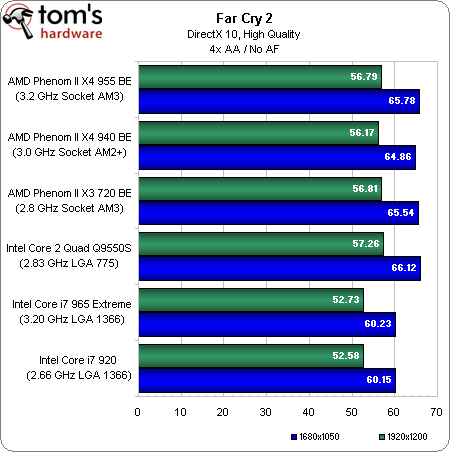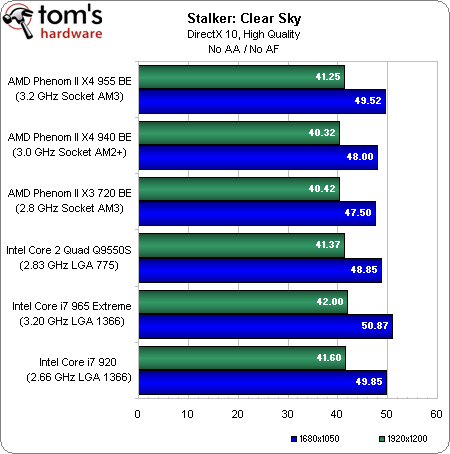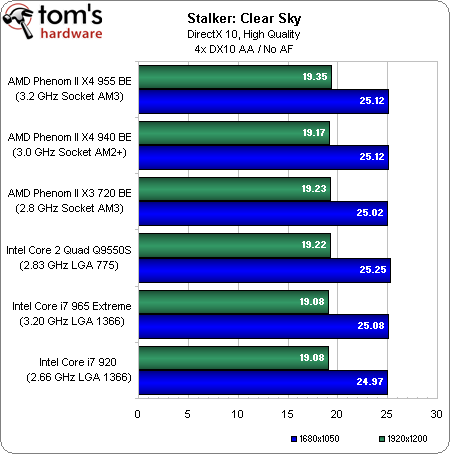Phenom II X4 955: AMD's Dragon Platform Evolves
Benchmark Results: Far Cry 2 And Stalker: Clear Sky
An old gremlin is back to haunt us. We observed some very strange gaming results in our Socket AM3 platform launch coverage—results that were odd enough to warrant a follow-up and close cooperation with Nvidia to diagnose. Well, nothing ever came of those efforts really, despite an exhaustive number of benchmarks being run to test the possible cause of slow-downs with Core i7 and Nvidia graphics hardware. Bear in mind that the results we’d see here would differ dramatically if we were using ATI hardware—a fact demonstrated on page two of my most recent Editor’s Corner analysis.
The consequence is a positive for AMD though, as the Phenom II X4 955 and Core 2 Quad Q9550 deliver the most compelling experiences in Far Cry 2 without anti-aliasing or anisotropic filtering enabled. Let’s see what turning on the visual details (and further taxing the graphics hardware) does to the results.
Core i7’s lagging performance continues, even with details cranked up. The Core 2 Quad actually serves up the best numbers followed closely by the Phenom II X4 955. It’s a miniscule difference, though. Do we see the same gaming conundrum surface In Stalker: Clear Sky?
Nope. Intel’s Core i7/Nvidia’s GeForce GTX 260 Core 216 reasserts its dominance (to be fair, we’re talking about tenths of a frame per second, on average here). Stalker is a particularly graphics-intensive title, so we’re seeing the GeForce card keep scores fairly normalized. We’d expect the same—to a higher degree—with AA enabled.
All of our tested processors fall within one frame per second of each other at both 1680x1050 and 1920x1200—both resolutions largely unplayable with anti-aliasing turned on. If you wanted faster frame rates in this one, you’d need a beefier GPU.
Fortunately, the issues encountered in Far Cry 2 with i7 hardware and Nvidia GPUs end on this page. Moving forward, everything else looks much more normal.
Get Tom's Hardware's best news and in-depth reviews, straight to your inbox.
Current page: Benchmark Results: Far Cry 2 And Stalker: Clear Sky
Prev Page Benchmark Results: Productivity Next Page Benchmark Results: Left 4 Dead, WiC, Grand Theft Auto 4-
inmytaxi Why call a 955 $255 plus 790GX mb $110 plus 4 gb ram $41 is $500, when it's actually $410 before shipping and rebates, which about cancel out? And that's just picking off the cheapest at newegg and not price shopping, which might knock it below $400.Reply
Not to mention the six months on the market the other set up has had to drop in price ... -
inmytaxi Of course, even at NewEgg, the i7 is still just a benny more, at $280 for the i7, $84 for 1600 6gb ram and $200 for a MB. What's, $564 before ship and rebates, knock $50 if you get the i7 at microcenter, and another $20 on real cost after nit picking out shipping and rebates ... and settle for 1333 ram ... you're within fifty bucks!!!Reply
If it wasn't for that Nvidia issue with the i7 ...
Hell, -
inmytaxi Hell, you can knock seventy off the hundred dollar price diff. with an open box motherboard for one thirty instead of twoo hundred.Reply
Nice processor, but until the price drop comes the only reason to buy it is if you're upgrading. If you're doing a clean sweep it's the i7 all the way.
-
gsacks inmytaxiHell, you can knock seventy off the hundred dollar price diff. with an open box motherboard for one thirty instead of twoo hundred.Nice processor, but until the price drop comes the only reason to buy it is if you're upgrading. If you're doing a clean sweep it's the i7 all the way.Reply
Not fair. Don't compare open box prices to new prices. If you want to buy used/refurb/reconditioned/open box, then compare the prices against the same used/refurb/reconditioned/open box equivalent for the other platform. Otherwise, you are fudging your numbers.
-
trevorvdw "The only standout in this clumsy console port is AMD’s Phenom II X3 720, which lags at both 1680x1050 and 1920x1200. The rest of the processors serve up reasonably close performance, per what we’ve come to expect from Grand Theft Auto 4."Reply
Yeah that whole less than 10% behind the i7 920 is totally lagging and not close in performance... who writes this drivel? -
for gamers: seriously, get the 720BE and oc it to death. then spend your money on VIDEO CARD(S)... that's what's important here!Reply




